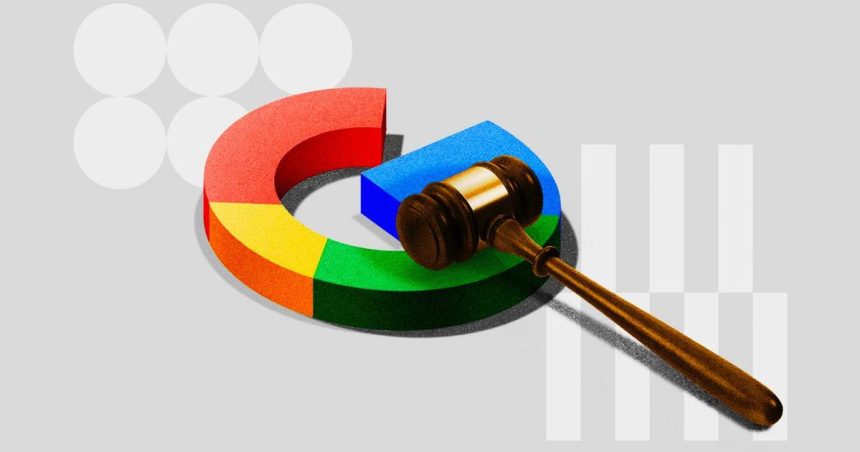For its closing argument in United States v. Google, the Department of Justice played the hits.
Since the trial kicked off in September, US District Court Judge Leonie Brinkema has heard testimony from publishers, tech executives, advertisers, Google employees, and economists, each attempting to make sense of the tangled knot called programmatic advertising.
In a final sprint held Monday in Alexandria, Virginia, lawyers with the DOJ and Google repeated much of the same arguments the court had already heard over the course of the initial three-week trial before a month-long recess.
Lawyers with the DOJ argued that Google owns the entire ad-tech supply chain, including the largest ad server and the largest exchange, as well as an untold supply of advertisers, and that by tying these together, it unlawfully choked out competition. Google is “once, twice, three times a monopolist,” DOJ attorney Aaron Teitelbaum said.
The DOJ has alleged that Google created favorable terms for itself and that it had visibility into nine out of every 10 open-web display transactions, but that those favorable terms did not extend to its customers, publishers, and advertisers.
To emphasize the point, the government referenced emails that it introduced during the trial, including one where an exec compared Google’s market position to if “Goldman or Citibank owned the NYSE” and that Google would “do to display what we did to search.” In remarks like these, Google employees were “saying the quiet part out loud,” Teitelbaum told the packed courthouse.
Brinkema pointedly asked Teitelbaum why the DOJ hadn’t called any advertisers to testify, instead relying on testimony from media buyers and agencies. His answer? Because agencies are the ones with their hands on the tools. She also noted that the DOJ’s case relies heavily on Google’s sell-side business and less on the buy side. Over the course of the trial, one claim from the DOJ alleging that Google had monopolized advertising networks essentially disappeared from the case.
In its defense, Google’s lawyers have claimed the company’s dominance is a testament to its superior technology and have argued that it excels in a hypercompetitive market, facing off against other Big Tech giants like Meta, Microsoft, and TikTok.
In her closing, Google’s lead attorney Karen Dunn pointed to two Supreme Court decisions—Ohio v. American Express Co. and Verizon v. Trinko—to argue that Google’s operations are legal. In the AmEx case, the court ruled in the credit-card company’s favor in a 5-4 decision, with the majority arguing that when companies operate a “two-sided market,” both sides need to be considered to establish a monopoly. In the latter, the court said that companies aren’t bound to work with competitors.
In other words, Dunn argued, Google can bind publishers to its ad tech if they want access to its advertisers. (Dare we say that the case-law segment of the trial rivaled the complexity and dryness of the hours spent on programmatic auction economics?)
Get marketing news you’ll actually want to read
Marketing Brew informs marketing pros of the latest on brand strategy, social media, and ad tech via our weekday newsletter, virtual events, marketing conferences, and digital guides.
Dunn also referenced a line from earlier in the trial belonging to former News Corp employee Stephanie Layser, who said on the stand that Google’s ad exchange should be turned into a “community” property or asset. Dunn insinuated that this sounded more like central planning than pure competition.
When Dunn began to assert that Google was a collaborative workplace where employees could share ideas freely, Brinkema cut her off, calling the inclusion of internal messages “dangerous territory.” Google has repeatedly been accused, including during this trial, of encouraging employees to delete internal messages, including those that could potentially reveal anticompetitive behavior.
In closing, Dunn compared Google to three other notable antitrust cases—Standard Oil, AT&T, and Microsoft, which, she claimed, all had a much greater market share of their respective markets than Google has in digital advertising. This prompted Brinkema to ask if Dunn’s definition of digital advertising included things like streaming and mobile-app advertising, neither of which are a focus of this case. Dunn said that it did, and that Google couldn’t produce an apples-to-apples measure of display advertising because “nobody thinks about the market this way,” she said, returning to an ongoing back and forth between Google and the DOJ over the definition of what exactly counts as “open-web display inventory.”
In the last minute of the trial, Dunn asked if any more evidence needed to be introduced, to which Brinkema cut her off, saying she’d already seen “thousands of pages,” to laughs from the courtroom.
What now? Judge Brinkema’s decision could massively disrupt the way digital ads are bought and sold, as Google is the world’s largest advertiser. Google’s advertising network business brought in $7.4 billion last quarter, and that doesn’t include either Search or YouTube revenue.
This year, Google is already 0-1 against the government. In August, a federal judge found that Google had monopolized online search, siding with the DOJ and striking a blow to Google’s most profitable line item, and the data that informs Google’s advertising business. In that case, the DOJ has proposed that Google sell its Chrome web browser, as well as end its use of exclusivity agreements like the ones it currently has with companies including Apple and Samsung, as a remedy, although President-elect Donald Trump has previously voiced skepticism about breaking Google up. The result and remedy of that case, though, will have no bearing on Google’s ad-tech case.
For now, the ad-tech industry will have to wait. Brinkema’s decision isn’t expected until the end of this year or in early 2025.
Read the full article here










